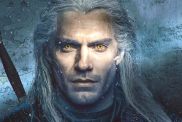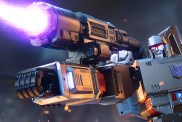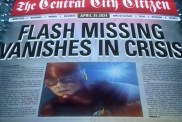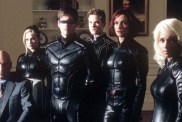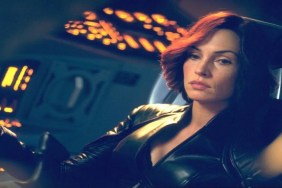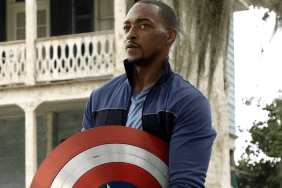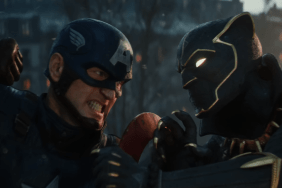“95% of this movie takes place in the past. The bookends are in the modern day. The very first scene of the film is the discovery in the arctic. If you know anything about Cap, you might know what that discovery is.”
As we move throughout the room it becomes evident that the images are from every scene of the film, laid out in order – a giant, ornate storyboard, currently being narrated by Feige.
“We meet young Steve Rogers, scrawny Steve Rogers, trying to enlist. Classic origin story, right out of the first books. He runs into a little trouble, and isn’t very good at handling it himself. He and his friend Bucky, who was not labeled ‘4F,’ and does go off into the war, spend his last night in New York exploring the ‘World of Tomorrow Expo,’ in which they get a glimpse of a young guy named Howard Stark, who’s working on trying to get a car to fly.”
Feige gives details of what we can expect, while production designer Rick Heinrichs explains some of the designs.
“One of our guys, Daniel Simon was a car designer originally, and so we’ve been able to utilize a lot of his knowledge and skill in developing a lot of the Hydra inspired design aesthetic; which is based, a little bit on German fascist sensibilities, but pushed into a fictionalized villain stylisation.”
The pair continue to explain the drawings on the walls, occasionally checking themselves so as to not give too much away. As we finish our tour of the room, Feige directs our attention to a series of paintings of HYDRA vehicles, several tanks, a train, and finally a coupe. The drawing includes a number of people to give an idea of the scale of the vehicle. It dwarfs them.
A few minutes later we’re on a soundstage, looking at the real thing. It’s colossal. The room is full of props from the film, a tank in one corner, the rebirth chamber in another, HYDRA bikes, gun turrets and control stations scattered around, and even more concept art lining the walls. In spite of all of these distractions, the coupe, with dimensions not too dissimilar to a train carriage, still dominates the space. Walking around it, it’s somewhat surprising that it exists in the real world, and hasn’t simply been rendered in a computer. It’s that unreal. It’s even more surprising that it actually drives. Remarkably, the two other vehicles on display in the room, the HYDRA bike, and the HYDRA tank, also drive, although it’s impossible for the stuntmen inside the tank to see out, so they must receive instructions via radio.
What’s striking about all of these vehicles and props is how, in spite of looking very sci-fi, and retro-futuristic, they also seem appropriate for the 1940s setting. Stephen Broussard, co-producer on the film, sums it up perfectly, “We’re not making ‘The Thin Red Line’ or ‘Band of Brothers’ or anything else like that. What we can do that those films can’t is the Marvel version of the time period, peel back the layers, and suggest that there’s a secret history, with secret good guys, and secret bad guys, that you never knew about and that are sort of lost to history.”
Eventually we are ushered towards a screen on the far side of the room, where Feige introduces a very rough cut of the sequence in which Steve Rogers is transformed into Captain America. The footage is impressive. It has the same, pulpy feel as “The Rocketeer,” both in appearance and in tone, and, at least in those few minutes, Evans feels the perfect fit for Rogers. That this little snippet works, in spite of being out of context, and having only temporary effects in place, bodes well for the finished movie.

“We decided after much research that we really wanted to use the character, and use the actual performances we were going to get out of Chris Evans, who is our Captain America. We did a lot of research trying to figure out how we were going to do that,” reveals Townsend, “We thought about doing full, computer-generated versions of the character, we thought about using a different actor, all that kind of stuff. We eventually came up with this idea of doing a real combination of a multitude of things, really trying to capture the essence of Chris Evans’ performance in everything we do, so that when people go to see the movie at the beginning, they get used to seeing this character of Chris Evans as Steve Rogers, then later on he’s transformed, and there’s that revelation of who he becomes, as Captain America.
“One of the things we really wanted to do was to be able to use all of Chris’ performances’. With the help of some test shots, Townsend explains the process that the VFX team have created to make this possible. “So what you’re looking at here is that muscle guy, and he’s been shrunk. We’ve scaled him down, and we’ve thinned him out, we’ve taken off his muscles, we’ve reduced the shading underneath his pecks, and around his abs to make him look as skinny as possible.” Flicking between two shots the difference is remarkable. In one image we see a tall, well-built man, in the other a much smaller, more frail version. And yet neither looks ‘unreal,’ and they are both clearly the same person.
“It’s still a work in progress, but it proved a point that we could actually take the performance of Chris Evans, and scale that down.” Townsend is clearly proud of the technique his team have developed, “It’s quite interesting when you compare the difference between the two, that that’s what we’ve done, we’ve taken that big guy, and literally scaled him down. It’s something we’ve never seen before, this technique in visual effects. It’s been done just making people look a little bit thinner, make them look a little bit more muscular, that sort of technique has been done, the digital plastic surgery. What we’re doing here is really taking it one step further to really transform the body and make him look totally different.”
As important as it is to get the look of ‘Skinny Steve’ right, and as exciting as the vehicle designs are, the thing that we are really anticipating on the set is the suit. Thus far we’ve seen paintings of it and watched Evans’ stunt double, in costume, on a monitor, but as we walk through the doors of the costume department we’re confronted with three different versions.
The first, the outfit Rogers wears while a part of the USO show, is straight out of Captain America number one. Made of wool, impractical, and utterly ridiculous, it’s a perfect real-world interpretation of an outfit from the Golden Age comic. For costume designer, Anna Sheppard, this costume was “the easiest one.” Having decided to base it directly on the costumes from the comics, Sheppard’s job was fairly simple, as she “[couldn’t] really go away from the original design that existed.”
Opposite the USO show costume is an outfit that Sheppard refers to as “the intermediate costume.” While it retains the top from the USO costume, the outfit looks much more practical, with a standard issue helmet (painted blue, with the letter ‘A’ sprayed on, a pair of khaki trousers, and a brown leather jacket. This was much more difficult for the costume department to realize, as Sheppard explains, “This one took us quite a while, because this is his costume when he escapes the USO show and goes to rescue Bucky. It has to have elements of military, obviously. We kept [the top from the USO show] underneath. Even his trousers were a big discussion point, and we went finally for paratroopers’ trousers, with paratroopers’ boots.”

Evans certainly seems to like it, as Sheppard explains, “Chris was pleased with his costumes. After he tried his USO [outfit][ he was very relieved to have something more manly… It looked very different on the mannequin, and putting it on the right body, and right actor really helps. It’s given it life.”
Leaving the costume department, we head to the main stage, where Evans and Weaving are filming. Evans had described the scene as “kind of my battle with Red Skull on his giant plane… we’re in this monstrous cockpit… it’s a lot of stunt work, and bumps and bruises,” which does the actual sight before us little justice. Almost the entire floor of the stage is covered in scaffold towers, holding an enormous rig about fifteen feet up in the air. On a separate scaffold tower a grip controls a wind machine, at its base, a pulley team stand ready to hoist actors into the air on command.
Inside the structure is even more impressive. All over are arches, and gangways, pipes, railings and control consoles. On the central walkway Weaving, in full Red Skull costume, sits in a chair at the front of the ‘aircraft,’ while Evans approaches him, brandishing his shield. In front of them, Johnston and his camera crew prepare to shoot. Meanwhile the two gantries either side of the central walkway buzz with the sound of other crew members getting ready for a take. It seems like everyone is here, sound recordists, VFX crew, art directors, prop builders. So many, in fact, we can’t help but think some of them have simply found an excuse to be there so they can watch the scene being filmed.
And then it begins. The AD calls ‘standby’ and a silence falls over the room, quickly replaced by a low roar, as the wind machine starts up. As it builds up speed the noise increases, until it makes it difficult to hear much else in the room. The cameras roll, the sound starts recording, then ‘action.’ Evans moves first, charging towards Weaving, shield in hand. Weaving stands, braced and ready to face his opponent. The fight between Captain America and Red Skull begins…
